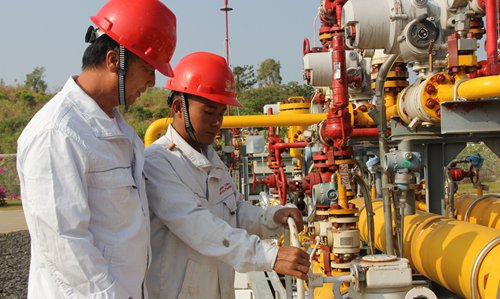A wharf on Made Island, the starting point of the China-Myanmar crude oil and gas pipeline, awaits giant oil tankers. Courtesy: China-Myanmar crude oil and gas pipeline project
It was completely dark outside at night when this Global Times reporter visited Kyaukpyu county, Myanmar eight years ago. Now, the city has witnessed tremendous changes thanks to the China-Myanmar crude oil and gas pipeline, a pioneer project of the China-proposed Belt and Road Initiative, local citizens told the Global Times.
The pipeline project serves as the fourth energy import channel after the China-Central Asia pipelines, China-Russia oil pipeline, and the Middle East. As a result, the project has a strategic significance for China’s energy diversification and security, said Zhang Qiang, manager of the project of Sino-Pipeline International Company. He noted Myanmar also benefits a great deal from the project.
Filling up
An oil tanker stops at a western Myanmar port in Kyaukpyu county. Three oil delivery pipes are lowered down to unload oil into its 100,000-ton oil storage tank.
That oil will go through the 771-kilometer-long China-Myanmar crude oil pipeline and head to China from Namhkam, Shan State in eastern Myanmar.
In the same way, the natural gas gathered from southwestern Myanmar will go through the China-Myanmar gas pipeline.
“The China-Myanmar crude oil and gas pipeline allows crude oil from the Middle East to bypass the Malacca Straits and go ashore on Made Island, which faces the Andaman Sea in the Indian Ocean. The oil will eventually arrive in China’s southwestern region,” Zhang told the Global Times.
He noted that Myanmar requires less than 2 million tons of crude oil and 2 billion cubic meters of natural gas to promote local economic development and raise people’s standard of living.
Every day, about 602,700 cubic meters of natural gas are supplied from the starting station in Kyaukpyu county and transferred to the local power station.
Inh Malh owns the tallest building in the county. At least half of the 40 rooms in the eight-floor hotel are usually booked, according to him.
“Nobody wanted to visit Kyaukpyu county in the past, because it used to be totally dark at night. Locals didn’t want to go outside either. The electricity provided by the government could only be used for two to three hours per day. Private electric lamps cost $30 per month,” he said, “Now, the county’s economy has improved a lot thanks to the China-Myanmar gas pipeline, because the electricity generated in the power station came from the natural gas transferred via the pipeline.”
About 60 percent of the townships and regions in Myanmar are unable to guarantee uninterrupted power supplies. Forty days after the pipeline project went into operation in September 2013, the Kyaukpyu station started supplying natural gas to local power stations. The daily power supply increased from three hours to 24 hours, and electricity charges were also reduced.
“With the natural gas provided by the China-Myanmar gas pipeline, Kyaukpyu becomes the first county in Rakhine State to generate power with natural gas and realize a 24-hour power supply,” the head of Kyaukpyu county said.
In addition to Kyaukpyu, the northern Mandalay and central Yenangyaung gas stations can provide about 2.7 million cubic meters during peak hours to ease energy demand.
The 793-kilometer China-Myanmar natural gas pipeline has six stations, and aims to transfer 12 billion cubic meters of natural gas annually. Myanmar’s usage comes to less than 20 percent of the total traffic amount.
According to Yuan Yundong, head of the project’s production and operation team, the China-Myanmar natural gas pipeline helped Myanmar collect 3.1 billion cubic meters of natural gas as of February, which goes to power stations in Kyaukpyu, Taneekarn and Mandalay.
The pipeline started operating in May 2, 2017. As of February, it has transferred 17.53 million tons of oil to China. The potential traffic amount at the five stations is 22 million tons.

Bringing jobs
According to the Asian Development Bank, Myanmar’s economic growth looks set to be first among the Southeast Asian nations. The China-Myanmar pipeline project solves the problem of Myanmar’s downstream market, earns foreign exchange through exports and brings in national revenue.
In terms of employment, statistics show the pipeline project hired more than 2.9 million people and more than 6,000 local people were employed during the construction peak.
What’s more, the project provides training for around 800 Myanmar workers, accounting for 80 percent of total employees, in positions ranging from installation worker to welders.
Hn Um, who graduated from the department of mechanics at the University of Yangon, is now a technician at Mandalay station. He previously studied in China’s Southwest Petroleum University.
“We learned advanced technology from the training, which is needed not only for running the pipeline but also for our country,” he said.




